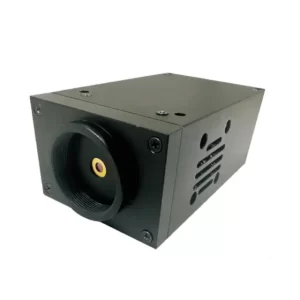Introduction
An InGaAs single-photon 4×4 array detector assembly is a specialized optical sensor module designed to detect extremely weak light signals at the single-photon level in the near-infrared (NIR) wavelength range. “InGaAs” stands for indium gallium arsenide, a semiconductor material sensitive to NIR wavelengths (typically ~0.9–1.6 μm) where silicon-based detectors no longer operate efficiently. The device incorporates a 4×4 array of indium gallium arsenide single-photon avalanche diodes (SPADs) – 16 tiny photodiode pixels that can each register individual photon events. These SPAD pixels are integrated with supporting circuitry (quenching electronics, cooling, and readout interfaces) inside a compact, rugged housing. The purpose of this assembly is to provide ultra-high sensitivity detection for applications requiring photon counting or imaging at the single-photon level, such as long-range laser detection, quantum communication receivers, and time-resolved optical measurements. Each pixel in the 4×4 array operates independently, allowing the device to capture spatial or multi-channel information about incoming light, effectively functioning as a 16-pixel single-photon camera or sensor. In summary, the InGaAs 4×4 SPAD array assembly is a self-contained detector unit offering single-photon sensitivity in the NIR spectrum, high timing resolution, and multiple parallel detection channels in a small form factor.
Operating Principle of InGaAs SPADs and 4×4 Array Function
InGaAs SPAD Operation: The detector pixels in this assembly are InGaAs/InP single-photon avalanche diodes, which operate in the so-called Geiger mode to achieve single-photon sensitivity. In normal linear mode, an avalanche photodiode (APD) produces a proportional photocurrent for incoming light below its breakdown voltage. In contrast, when biased above the semiconductor’s breakdown voltage, the APD enters Geiger mode and behaves as a SPAD (single-photon avalanche diode): the absorption of a single photon can trigger a self-sustaining avalanche of charge carriers, generating a fast, discrete electrical pulse as a detection signal. Essentially, each InGaAs SPAD pixel is a tiny diode junction engineered with an InGaAs absorption layer (to efficiently absorb NIR photons) and an InP multiplication layer that provides a high electric field for avalanche multiplication. When a photon is absorbed in the InGaAs region, it creates a charge carrier that is swept into the high-field InP region, initiating a cascade of impact ionization. This results in a sudden current spike indicating a photon event. The SPAD’s quenching electronics then quickly arrest (quench) the avalanche by lowering the bias or using a passive resistor, allowing the pixel to reset for the next photon detection. Each detection is binary (photon or no photon) but with precise timing of the avalanche pulse, enabling time-of-flight measurements or coincidence timing with picosecond resolution.
Quenching and Cooling: A crucial part of the operating principle is the quenching circuit attached to each SPAD. In this 4×4 assembly, each pixel is paired with a fast active or passive quenching circuit (integrated via CMOS chip) that independently handles the avalanche pulse. The quenching circuit stops the avalanche within a few nanoseconds and enforces a brief dead time (on the order of tens to hundreds of nanoseconds) to allow the diode to recover and to avoid afterpulsing (spurious avalanches from trapped carriers). The assembly also includes a thermoelectric cooling module that chills the SPAD array (often to around –30 °C or lower). Cooling dramatically reduces the thermal dark counts (false triggers due to thermal carrier generation) in InGaAs SPADs, improving the signal-to-noise ratio for single-photon detection. For example, a typical cooled InGaAs SPAD in Geiger mode might achieve a photon detection efficiency ~10–25% at 1550 nm with a dark count rate on the order of 10^4 counts per second, whereas at room temperature the dark noise would be orders of magnitude higher. Modern device improvements (guard ring designs, material purity, and circuits) continue to push these metrics – recent research detectors have achieved up to ~60% photon detection efficiency at 1550 nm in lab settings and dark count rates of only a few hundred counts per second by using advanced cooling and gating techniques.
4×4 Array Functionality: Having a 4×4 array of SPAD pixels means the detector provides 16 parallel single-photon channels. Each pixel is a small, independent sensor (e.g. ~85 µm active area with 100 µm center-to-center pitch) that outputs a digital pulse whenever a photon is detected in that pixel. The assembly’s signal processing module typically outputs a TTL or LVDS pulse per pixel in real time. The array can be used to capture a simple 4×4 pixel image of a faint light source or scene, or it can serve as multiple coincident detectors for separate signals. In many applications, the 4×4 layout is not so much for forming a detailed image as it is for increasing the effective collection area or field of view, and for facilitating spatial filtering or multi-target detection. For instance, the array can cover slightly different angles; in a laser ranging system, this allows acquisition of returns from multiple objects or improves robustness to beam misalignment. Each SPAD in the array operates independently and freely in Geiger mode – meaning one pixel detecting a photon has no immediate effect on its neighbors (aside from minor electrical or optical crosstalk, which designers strive to minimize with isolation structures). This independence is important for applications like photon timing and quantum optics, where each pixel might be assigned to detect a different time slot, polarization, or spatial mode. The 4×4 array is a relatively small format (16 pixels), which simplifies the readout electronics and achieves high uniformity; at the same time, it offers a modest spatial resolution advantage over a single detector, enabling multipixel coincidence measurements or rudimentary imaging. Overall, the array architecture grants flexibility: the detector can perform as a mini imaging sensor or as a multi-channel photon counter, with all pixels working in parallel to capture more information than a single-element detector.
Development History and Technological Advancements
The technology behind InGaAs single-photon detector arrays has advanced significantly over the past two decades. Early developments in the late 1990s and early 2000s established the feasibility of using telecom-wavelength InGaAs/InP avalanche photodiodes in Geiger mode for single-photon counting – a capability crucial for quantum key distribution (QKD) and single-photon lidar demonstrations at 1.3–1.55 µm. These first-generation devices were typically single-pixel APDs operated in gated mode (the bias is pulsed above breakdown only for short intervals) to reduce dark counts and afterpulsing. By around 2004–2005, researchers demonstrated gated InGaAs SPADs enabling QKD over tens of kilometers of fiber. However, the early devices had limited detection efficiency (~10% or less), high afterpulse probabilities, and had to be operated at low temperatures and low gate frequencies (e.g. tens of kHz). Progress in device structure soon yielded better performance – for example, the introduction of planar InP/InGaAs APD designs with a buried junction and guard rings improved reliability and uniformity. Telecom APDs that were originally designed for linear mode operation in optical receivers were “re-engineered for single-photon detection” by raising their bias to Geiger mode. This repurposing leveraged the high material quality and low defect densities from telecom devices to get more efficient and lower-noise SPADs.
Throughout the 2010s, significant milestones were reached in both performance and array size. Researchers developed techniques like self-differencing and sine-wave gating (at GHz frequencies) to enable near-room-temperature operation and dramatically suppress afterpulsing, thus allowing much higher count rates. By 2010, free-running (ungated) InGaAs SPAD modules with active quenching became available, albeit with trade-offs in dark count. A major breakthrough in array technology was achieved by institutions like MIT Lincoln Laboratory and industry pioneers such as Princeton Lightwave Inc. They built some of the first InGaAs SPAD arrays for 3D imaging ladar and scientific applications. In 2010, Princeton Lightwave released a fully integrated 32×32 Geiger-mode APD focal plane array, featuring 100 µm pitch InGaAs/InP SPAD pixels hybridized to a CMOS readout chip. This device had on-chip active quench circuits and per-pixel timing electronics, capable of capturing a full 32×32 depth image (via time-of-flight measurements) at frame rates up to ~200 kHz. It also incorporated microlenses to boost fill-factor and a hermetic package with a two-stage cooler to maintain low dark counts. Such developments proved that sizeable 2D arrays with single-photon sensitivity in the SWIR (short-wave infrared) were practical. Around the same time, MIT Lincoln Lab demonstrated a 32×32 InGaAs SPAD array at 1.06 µm for airborne flash lidar, and Hamamatsu Photonics in Japan (in collaboration with JAXA) developed a 1k-pixel (32×32) SPAD camera for eye-safe robotic vision and planetary landing sensors. These projects addressed challenges like pixel uniformity, crosstalk suppression, and integration of timing circuits for each pixel.
In recent years, the focus has been on improving detector efficiency, noise, and scalability. On the efficiency front, experiments have pushed the photon detection efficiency of InGaAs SPADs above 50%. In 2020, one group reported >60% detection efficiency at 1550 nm by optimizing the APD structure and operating conditions – a dramatic improvement over earlier ~20% efficient devices. Timing resolution has also improved: modern InGaAs SPAD detectors achieve jitter on the order of 50–100 ps FWHM (full-width at half-maximum), suitable for sub-centimeter depth resolution in LiDAR. Meanwhile, innovations in reducing dark noise and afterpulsing have yielded devices with much lower dark count rates. For example, by 2021 researchers demonstrated low-noise InGaAs SPADs with dark count rates well under 1 kHz (at modest efficiency) for both fiber-based and free-space use. The use of negative-feedback mechanisms (integrating a tiny resistor at each pixel to self-quench the avalanche) has enabled truly free-running arrays without external gating, and clever circuit designs (e.g. double self-differencing, as developed by Toshiba Research and others) allowed GHz gating to be used effectively for high-speed QKD and ranging. Array sizes have continued to grow in research prototypes: a 64×64 InGaAs SPAD array was reported in 2022, indicating that multi-kilopixel arrays are on the horizon. Such larger formats are aimed at high-resolution 3D cameras and imaging systems, though they require increasingly sophisticated readout ASICs and crosstalk mitigation (for instance, trenches to block stray photons between pixels). The 4×4 array format, as addressed in this overview, has benefited from all these advancements – today’s 4×4 assemblies boast higher efficiency, lower noise, and more robust operation than earlier generations. They represent a mature compromise between complexity and performance: small enough to be readily integrated into instruments with relatively simple electronics, yet packing state-of-the-art single-photon sensitivity and multi-pixel capability.
Applications of InGaAs 4×4 SPAD Array Detectors
InGaAs single-photon detector assemblies find use in a variety of cutting-edge applications that require detection of very weak optical signals in the NIR. Some of the primary application domains include:
Quantum Communication and Cryptography: InGaAs SPADs are the workhorse detectors for quantum key distribution (QKD) and other quantum communication protocols operating at telecommunication wavelengths (~1310 or 1550 nm). These wavelengths are preferred for low loss in optical fiber and free-space channels, and the 4×4 SPAD array can be used to detect single photons carrying quantum information (for example, multiple pixels might be assigned to different polarization channels or time-bin slots in a QKD receiver). The low noise and high timing accuracy of cooled InGaAs SPADs enable reliable detection of quantum states even after long-distance transmission. Over the years, improved InGaAs detectors have directly translated into extended achievable distances and higher bit rates for QKD. Beyond QKD, such arrays are useful in quantum optics experiments (e.g. entangled photon detection, quantum teleportation setups) where multi-channel single-photon counting is needed. Having an array allows parallel detection of several spatial modes or performers of coincidence measurements between pixels, which is valuable in quantum entanglement and correlation studies.
Laser Ranging and LIDAR: One of the key uses of InGaAs SPAD arrays is in eye-safe LIDAR systems and long-range laser ranging. Because 1550 nm lasers are eye-safe at higher powers, they are often used in high-performance lidar; an InGaAs SPAD array serves as the receiver that can detect returning laser pulses from distant targets at the single-photon level. The 4×4 array format is especially useful in flash LIDAR configurations, where a broad laser pulse illuminates a scene and the array captures a 4×4 pixel depth map in one shot. Each pixel measures the arrival time of photons from its portion of the scene, enabling three-dimensional imaging. For example, Princeton Lightwave’s 32×32 arrays were used to build 3D imaging systems that could map terrain or targets at high frame rates. A 4×4 array can be used in smaller-scale systems or as a building block of larger arrays. Long-distance rangefinders (such as those for aerospace or military use) also benefit from these detectors. The high sensitivity allows detection of returns from targets several kilometers away with very weak return signals. An experiment in 2013 demonstrated depth imaging at up to 1 km distance using a gated InGaAs SPAD module with only ~600 μW average laser power – achieving ~26% detection efficiency and centimeter precision in broad daylight. For autonomous vehicles and robotics, arrays of InGaAs SPADs are being explored for lidar sensors that work in rain, fog, or glare conditions where single-photon sensitivity can help pick out faint returns. The 4×4 array’s pixels can also be used in cooperative timing, for instance, to detect multi-return echoes (near and far targets simultaneously) or to reject spurious triggers via coincidence logic. Additionally, these detectors are used in laser communication trackers and “optoelectronic radar” systems – effectively optical analogues of radar – where a single-photon array can detect and time-tag laser pulses reflecting off objects for positioning and navigation.
Biomedical and Scientific Imaging: InGaAs SPAD detectors have opened up new possibilities in biomedical imaging and spectroscopy in the NIR range. Many biological tissues are more transparent in the “NIR window” (~1000–1700 nm), so single-photon detectors at these wavelengths enable techniques like time-resolved diffuse optical tomography and fluorescence lifetime imaging deeper in tissue. For example, time-correlated single-photon counting (TCSPC) systems using InGaAs SPADs can detect faint fluorescent markers that emit in the NIR or track photons passing through turbid media to probe tissue structure. A 4×4 SPAD array could be used to collect multiple spatial points of light emerging from tissue, improving imaging throughput for diffuse optical imaging. Likewise, in near-infrared fluorescence lifetime measurements (e.g. for clinical diagnostics or molecular imaging), InGaAs SPAD modules (such as the ID Quantique ID230 mentioned below) have achieved sub-100 ps timing precision, enabling precise decay curve measurements for fluorescent dyes in the NIR. Another biomedical use is in deep tissue LiDAR or ranging, where one might send a NIR pulsed laser into tissue or blood vessels and use a SPAD to detect back-scattered photons for measurements of blood flow or organ dimensions – the single-photon sensitivity is critical since very few photons return. Beyond biomedicine, scientific applications include laser spectroscopy (e.g. Raman spectroscopy at 1064 nm where InGaAs SPAD can serve as the detector for weak Raman signals), and astronomy/astrophotonics – for instance, single-photon counting of IR photons from faint astronomical sources or optical communication from satellites. The compactness of a 4×4 module makes it attractive for field instruments. Notably, the array can also facilitate multiple simultaneous measurements: in a fluorescence experiment, different pixels could be assigned to detect different wavelengths (with filters) or different locations, all synchronized in time.
Optical Warning Systems and Other Uses: The ability to sense single photons at NIR wavelengths lends itself to specialized sensor systems such as laser warning receivers. Military or aviation safety systems use these detectors to pick up very faint incoming laser signals (for example, the glint of an adversary’s rangefinder or designator). The high sensitivity and fast response of the SPAD array allow detection of a laser pulse even if only a few photons hit the sensor, and the multiple pixels can help ascertain the direction or angle-of-arrival of the threat laser. In free-space optical communication, a 4×4 SPAD array can act as a fast acquisition and tracking sensor – if a communications beam wanders, different pixels will register the signal, and the system can feedback to point the receiver correctly. This was useful in demonstrations of space-to-ground laser communications where single-photon APDs were used to receive data from satellites over large distances. Research is also ongoing in emerging fields like quantum LIDAR or photon-counting passive imaging, where arrays of single-photon detectors could form the core of ultra-low-light imaging systems (for instance, seeing objects in moonlight or through obscurants by counting individual photons). In all these applications, the InGaAs 4×4 SPAD assembly’s combination of sensitivity, speed, and modest pixel count strikes a balance between performance and complexity, making it a versatile tool for engineers and scientists.
InGaAs SPAD Key Manufacturers and Notable Models
Given the specialized nature of InGaAs SPAD array technology, relatively few companies and research labs produce these detectors. Below are some of the key manufacturers and current (or recent) models in the market, as well as notable contributors to this technology:
Lontenoe Optoelectronics – Lontenoe offers a commercial InGaAs 4×4 SPAD array detector module (advertised as a “sensitive detection” component). This module integrates a 4×4 InGaAs APD chip flip-chip bonded to a CMOS quenching/readout circuit, along with a TEC cooler, high-voltage supply, and control electronics. The array pixels are 100 µm pitched and yield at least 10% photon detection efficiency at 1.57 µm, with a typical dark count rate ≤10 kHz per pixel when cooled. The unit provides TTL outputs for each pixel and allows adjustable settings like dead time and detection threshold. This product (and similar ones by Lontenoe or affiliated entities) is designed for applications like long-range laser ranging through obscurants, space laser communication, and NIR laser warning systems. It exemplifies the state-of-the-art in compact 4×4 SPAD assemblies available off the shelf today.
Princeton Lightwave (USA, now part of Argo AI/Ford) – Princeton Lightwave was a pioneering company in Geiger-mode InGaAs APD arrays. Their 32×32 GmAPD Focal Plane Array (introduced ~2010) was a landmark product, and they also developed smaller arrays and single-element modules. While the 32×32 was aimed at high-end lidar and 3D imaging systems, Princeton Lightwave also built modules suitable for quantum communication research (for example, they supplied InGaAs SPAD detectors to labs and partnered on QKD demos). After the company’s acquisition, the technology transitioned toward automotive lidar (Argo AI’s self-driving car lidar program). Although Princeton Lightwave as an entity is no longer independent, its legacy models like the 32×32 array (with variants optimized for 1064 nm and 1550 nm) remain significant. Those FPAs featured <~500 ps timing jitter, integrated active quenching on every pixel, and were packaged with two-stage TEC cooling. Today, companies like Ouster (which acquired some of Argo’s assets) and others in the defense sector likely carry on manufacturing similar InGaAs SPAD array sensors for 3D imaging. Princeton Lightwave’s work also demonstrated that even larger formats (e.g. experimental 128×32 arrays) are feasible, pointing the way for future high-pixel-count SPAD cameras.
ID Quantique (Switzerland) – ID Quantique is well-known for its single-photon detection modules, especially in quantum communication. Their product line includes InGaAs/InP SPAD modules such as the ID210 (gated mode detector) and ID230 (free-running detector). The ID230 in particular is a free-running InGaAs SPAD module that achieves impressive performance: up to ~25% detection efficiency at 1550 nm, timing resolution around 80 ps (with specialized timing electronics), and extremely low dark count rates on the order of a few hundred counts per second. These modules are single-pixel, not arrays; however, they are often used in multi-channel setups (for example, a QKD receiver might use four ID230 detectors, one per state). ID Quantique’s detectors have become a de facto standard in quantum optics labs due to their reliability and performance. While IDQ has not publicly released a monolithic 4×4 array product, their devices can be and have been used to construct equivalent multi-pixel systems (by combining multiple single SPAD modules). They also provide integrated timing electronics and software for photon counting. IDQ’s continuous improvements (like reducing dark counts and afterpulsing via novel gating schemes) are frequently reported in the literature and have influenced the design of other manufacturers’ array assemblies.
Hamamatsu Photonics (Japan) – Hamamatsu, a large photonics company, has expertise in both photodiodes and specialized imagers. They have developed InGaAs SPAD arrays primarily for research and custom applications. Notably, Hamamatsu built a 32×32 SPAD array for flash lidar in collaboration with Japanese research institutions, incorporating their own APD fabrication and a CMOS timing readout. Hamamatsu’s contribution is significant because they bring high-quality semiconductor processing to the problem – for instance, in 2018 they demonstrated a 32×32 InGaAs SPAD sensor with improved pixel miniaturization (down to 55 µm pitch in newer versions, from 100 µm) to pave the way for larger arrays. As of mid-2020s, Hamamatsu does not list a commercial multi-pixel InGaAs SPAD module in their catalog, but they do offer custom SPAD array solutions and have related products like linear InGaAs APD arrays and single-photon counting modules. It is expected that Hamamatsu will be a key player if large-format InGaAs SPAD cameras become commercially available, given their success in silicon SPAD and multi-pixel photon counter (MPPC) technology. For now, those needing a 4×4 or similar may engage Hamamatsu for custom devices or leverage their components (e.g. InGaAs APD chips or ROIC designs).
Other Manufacturers and Researchers: A few other entities deserve mention. Laser Components (Germany/USA) markets InGaAs single-photon counting modules (often leveraging technology from research partners), although their branded “Count” series is more famous for silicon APDs. Excelitas (Canada, formerly PerkinElmer) produces InGaAs avalanche photodiodes and previously offered single-photon detector modules (like the SPCM-AQ series for Si); they have worked on gated InGaAs SPADs as well. Some specialized firms in China (such as Beijing RMY Electronics, which offers pigtailed InGaAs SPAD detectors, or Qasky and QuantumCTek for QKD systems) are also building and using these detectors. In the academic realm, groups like Politecnico di Milano (Italy) and NIST (USA) have been instrumental in advancing InGaAs SPAD tech – Politecnico di Milano demonstrated low-noise, low-jitter designs and even built small arrays for research, while NIST pioneered self-quenching “negative-feedback” SPAD designs for free-running operation. Startups occasionally emerge around specific applications (for example, Big Quant (China) focusing on single-photon imaging, or Specktr in the US). Additionally, the superconducting detector company Single Quantum (Netherlands) provides an alternative for NIR single-photon detection using nanowire detectors, but those require cryogenics and are not array-based in the same way. Overall, the market for InGaAs SPAD arrays is still niche but growing – driven by needs in quantum technology and autonomous sensing. The current readily available 4×4 modules, like the one described by EIPEKS/Lontenoe, offer a compelling blend of performance and integration, while higher-density arrays are on the cusp of broader availability as the technology matures.






